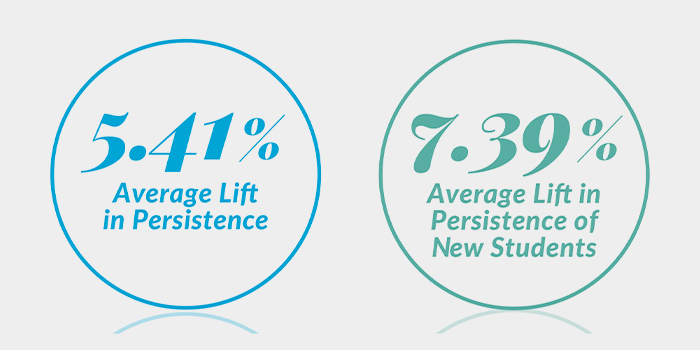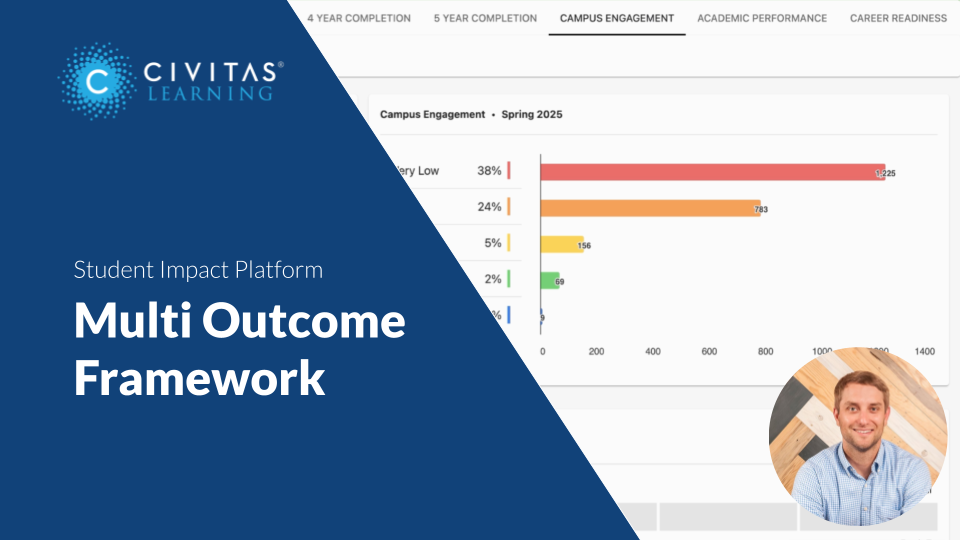
Simplified Scheduling Experience Boosts Persistence by 5-7%
Share this Post
Many students don’t persist toward on-time graduation because they find it challenging to fit the courses they need into their already busy lives. An increasing number of college students must consider work schedules, caregiving responsibilities, long commutes, or transportation constraints alongside course sequencing requirements and the availability of classes. Streamlined planning, scheduling, and registration processes supported by user-friendly technology improve the student experience by making it easier for students to live life and attend class.
Simplified Scheduling Experience Boosts Persistence by 5-7%
A Civitas Learning analysis of 15 partner institutions revealed that simply making it easier for students to create conflict-free schedules boosted persistence rates by 5–7 percentage points for student users compared to their peers who did not use the student scheduling capabilities.
The analysis included nearly 400,000 students at two-year and four-year public and private institutions. Across these partner schools, the average lift in persistence among students using the scheduling solution was 5.41%. And, among new students, persistence increased at an even higher rate of 7.39%. Institutions gained an average of 179 students per term through their investment in and deployment of the Civitas Learning student scheduling tool.

The study methodology matched students with the same predicted likelihood to persist and the same predicted likelihood to use the student scheduling tool and then compared each pair of students’ outcomes. This methodology helps to demonstrate that the lift in persistence among students who used the scheduling tool is a result of using the tool and not due to some other factor.
These findings show that a simplified, user-friendly scheduling experience boosts enrollment and persistence. When students can easily create a schedule that works with their other commitments, they’re more likely to register for the appropriate number of credits and incorporate suitable classes to continue progressing toward degree completion. When registration goes smoothly, students have a better experience with the institution they’re attending, and advisors can spend more time providing proactive support instead of cleaning up registration issues.
Complicated Course Scheduling Can Derail Progress Toward Graduation
A student may have an excellent advising experience and leave the appointment with an accurate list of courses to take. But suppose they struggle to identify a schedule that works for their lives. In that case, they may take fewer courses than recommended, register for classes that don’t advance their progress, cram courses into an unbalanced schedule, or choose not to register. These outcomes threaten a student’s academic success by potentially increasing time to degree completion, wasting financial resources, and increasing stress.
A poor scheduling and registration experience may also impact a student’s perception of the institution they’re attending and whether it’s the right place for them. Streamlining and simplifying the scheduling experience demonstrates to students that the institution recognizes the many responsibilities and wants to make it easy for them to fit their learning into their lives.
Streamlined Scheduling Experiences Support Retention and On-time Completion
Access to a student-centered scheduling solution offers a unified, streamlined planning, scheduling, and registration experience, making it easy for students to build a great schedule. Students can quickly identify their optimal schedule by auto-generating and comparing available courses that incorporate their scheduling preferences and outside commitments. This helps them balance their learning with their lives instead of settling for a less-than-optimal schedule, easing stress and paving the way for academic success.
As our internal data analysis demonstrates, institutions can realize significant gains of 5–7% in student persistence by providing an improved student scheduling and registration experience. Advisors can spend less time resolving registration difficulties and more time providing holistic support and outreach to students. Making it easier for students to fit learning into their lives creates more student satisfaction and a better student experience, increasing the likelihood they will remain enrolled and complete their educational goals.



